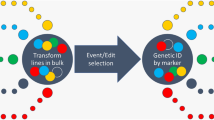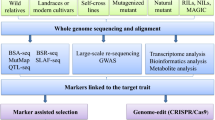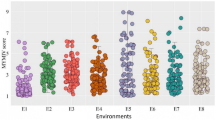Abstract
Background
July 20th, 2022, marks the 200th anniversary of the “Father of Genetics,” Gregor Mendel’s birth. His experiments with pea plants established the fundamental principles of genetic inheritance.
Main text
In this article, a succinct review of literature is hereby done to answer two key questions: (1) How Mendel’s principles of genetic inheritance helped us understand Mendelian disorders? and (2) How the study of Mendelian disorders can help us understand complex diseases?
Conclusion
This literature review concludes that continued effort to understand the genetic basis of Mendelian disorders will improve our understanding and treatment strategies for complex diseases.
Similar content being viewed by others
Background
The field of medical genetics has expanded to the point that we not only know the genetic underpinnings of many human diseases, but we are also able to cure some diseases, including sickle cell anemia, by editing the molecular lesions with gene therapies [1]. An appropriate evaluation of scientific literature from the historical perspective can trace these advancements back to the discovery of Gregor Mendel in 1865 which established the fundamental principles of genetic inheritance [2]. July 20th, 2022, marks the 200th anniversary of the “Father of Genetics,” Gregor Mendel’s birth. Commemorating Mendel’s 200th Birth Anniversary, a review of literature was carried out to find the answer for two key questions: (1) How Mendel’s principles of genetic inheritance helped us understand Mendelian disorders? and (2) How the study of Mendelian disorders can help us understand complex diseases? Findings from the literature review is succinctly presented in this article.
Mendelian theory of inheritance: birth of “genetics”
Inquisitive minds have wondered why living things tend to look like their parents and why some families are affected by certain diseases. However, there was a lack of understanding of the causal mechanisms. The early popular views included the “blending” of parental traits in their offspring [3]. An alternative theory proposed by Mendel based on the results of his experiments on pea plants challenged the existing theories. Using data from large-scale experiments on pea plants followed by a pioneering systematic mathematical analysis, Mendel was able to find a pattern for the transmission of contrasting trait pairs through generations. His experiments lead to the conclusion that each trait is determined by pairs of “antagonistic elements”, one dominates over the other in their manifestation, and rather than blending, they “segregate” among the progeny, and thus, are “particulate” in nature [4]. The Mendelian theory of inheritance also suggests that the assortment of one trait is independent of that of another trait. These particulate units of inheritance are now known as “genes”, and the antagonistic elements resulting from the variations in DNA sequences of a gene are called “alleles”. Unfortunately, Mendel’s work was not widely accepted during his lifetime. However, the rediscovery of Mendel’s work through independent experiments by Correns, de Vries, and Tschermak in 1900 ultimately established the principles of genetic inheritance and hailed Mendel as the “Father of Genetics”.
Mendelism relevant for both Mendelian and complex genetic disorders in humans
In humans, disease traits following Mendelian inheritance patterns are called “Mendelian disorders” and are commonly caused by variants in a single gene (“monogenic”). In contrast, diseases caused by the combined action of variants in many genes and their interactions with the environment, tend to show an apparent departure from Mendelian expectations and are considered as “complex” [5,6,7,8]. Mendel’s laws of inheritance, however, are applicable to complex traits since the inheritance of each of the genes involved in these diseases follows Mendel’s laws [9]. Thus, Mendel’s theories remain instrumental in revealing casual mechanisms for both monogenic and complex diseases.
Mendel’s principles of genetic inheritance helped us identify genes for Mendelian disorders
Early understanding of the genetic underpinnings of human diseases came from studying their inheritance patterns in families (pedigree analysis). These analyses together with knowledge of the location of the genes on chromosomes helped in finding the dominant and recessive nature of alleles of disease genes and differences in their inheritance patterns. Further advancements in our understanding of the molecular basis of genetic variants, as well as the technological capabilities to create genetic maps for chromosomes, eventually led to the localization and identification of disease genes. Computational methods, including linkage analysis, use naturally occurring DNA variations as markers to trace inheritance patterns in families to identify the location of disease genes on the chromosomes [10]. Furthermore, positional molecular cloning approaches have been successful in identifying genes responsible for Mendelian diseases [10]. Most Mendelian diseases are caused primarily by a single high-penetrance mutation in a family. These mutations affect the coding or other functional regions of a gene and have a low frequency within a population. Indicating major success, the Online Mendelian Inheritance of Man (OMIM), a catalog of human genetic diseases, now includes over 6000 Mendelian phenotypes with a known molecular basis [11].
The study of Mendelian disorders can help us understand complex diseases
Linkage analysis approaches remain largely unsuccessful for finding genetic underpinnings for common diseases that do not conform to Mendelian inheritance patterns and suggests a different genetic architecture for these complex diseases [7]. Genome-wide association studies (GWAS) suggest that complex diseases are associated with many high-frequency variants with low-effect sizes on disease susceptibility, which together explain a small fraction of disease heritability. These common variants are mostly located in the non-coding regulatory regions of the genome [5]. Despite differences in genetic architecture, current evidence suggests that complex and Mendelian traits might not be as biologically distinct as previously thought. For example, common and rare monogenic obesity are shown to have shared genetic and biological underpinnings, pointing to an important role of the brain in controlling body weight [12]. Several recent analyses of GWAS found significant enrichment of Mendelian disorder genes in GWAS gene sets for phenotypically matched complex traits. Genes affected by Mendelian disease-causing mutations are also dysregulated by noncoding variants in complex traits [13,14,15]. These findings support a shared genetic basis between complex and Mendelian forms of the disease.
Conclusion
The fundamental principles of genetic inheritance discovered by Gregor Mendel paved the path toward understanding human genetic diseases. In the bigger picture, Mendelian diseases arising from single genes and complex diseases caused by many genetic variants are two extremes in the continuum of the genetic architecture of human diseases [6, 16]. Thus, continued effort to understand the genetic basis of Mendelian disorders will improve our understanding and treatment strategies for complex diseases.
Availability of data and materials
All data included in this manuscript are from published literature and databases.
Abbreviations
- DNA:
-
Deoxyribonucleic acid
- GWAS:
-
Genome-wide association studies
- OMIM:
-
Online Mendelian inheritance of man
References
Eisenstein M (2021) Fix the gene, cure the disease. Nat Outlook 596:S2–S4
Birchler JA (2015) Mendel, mechanisms, models, marketing, and more. Cell 163:9–11
Stern C (1965) Mendel and human genetics. Proc Am Philos Soc 109(4):216–226
Zimmer C (2018) She has her Mothers laugh: the powers, perversions, and potential of heredity. Dutton (Penguin Random House LLC), New York
Lappalainen T, MacArthur DG (2021) From variant to function in human disease genetics. Science 373:1464–1468
Chakravarti A (2021) Magnitude of Mendelian versus complex inheritance of rare disorders. Am J Med Genet 185A:3287–3298
Claussnitzer M, Cho JH, Collins R et al (2020) A brief history of human disease genetics. Nature 577:179–189
McKusick VA, Peltonen L (2001) Dissecting human disease in the postgenomic era. Science 291:1224–1229
Plomin R, Haworth CMA, Davis OSP (2009) Common disorders are quantitative traits. Nat Rev Genet 10:872–878
Altshuler D, Daly MJ, Lander ES (2008) Genetic mapping in human disease. Science 322(5903):881–888
Online Mendelian Inheritance in Man (OMIM). https://www.omim.org. Accessed 24 Feb 2022
Loos RJF, Yeo GSH (2022) The genetics of obesity: from discovery to biology. Nature 23(2):120–133
Freund MK, Burch KS, Shi H (2018) Phenotype-specific enrichment of Mendelian disorder genes near GWAS region across 62 complex traits. Am J Human Genet 103:535–552
Blair DR, Lyttle CS, Mortensen JM et al (2013) A nondegenerate code of deleterious variants in Mendelian loci contributes to complex disease risk. Cell 155:70–80
Chong JX, Buckingham KJ, Jhangiani SN et al (2015) The genetic basis of mendelian phenotypes: discoveries, challenges, and opportunities. Am J Human Genet 97:199–215
Katsanis N (2016) The continuum of causality in human genetic disorders. Genome Biol 17:233
Acknowledgments
SSD acknowledges availability of library resources at Coy C. Carpenter Library, Wake Forest School of Medicine, Winston-Salem, NC. SSD also acknowledges critical help in research from Dr SK Das (Associate Professor, Department of Internal Medicine, Wake Forest School of Medicine).
Funding
Not Applicable.
Author information
Authors and Affiliations
Contributions
SSD completed literature review, wrote, and edited the manuscript. All authors read and approved the final manuscript.
Corresponding author
Ethics declarations
Ethics approval and consent to participate
Not Applicable.
Consent for publication
Not Applicable.
Competing interests
None.
Additional information
Publisher's Note
Springer Nature remains neutral with regard to jurisdictional claims in published maps and institutional affiliations.
Rights and permissions
Open Access This article is licensed under a Creative Commons Attribution 4.0 International License, which permits use, sharing, adaptation, distribution and reproduction in any medium or format, as long as you give appropriate credit to the original author(s) and the source, provide a link to the Creative Commons licence, and indicate if changes were made. The images or other third party material in this article are included in the article's Creative Commons licence, unless indicated otherwise in a credit line to the material. If material is not included in the article's Creative Commons licence and your intended use is not permitted by statutory regulation or exceeds the permitted use, you will need to obtain permission directly from the copyright holder. To view a copy of this licence, visit http://creativecommons.org/licenses/by/4.0/.
About this article
Cite this article
Das, S.S. Mendel paved the path toward understanding genetic diseases. Egypt J Med Hum Genet 23, 124 (2022). https://doi.org/10.1186/s43042-022-00339-0
Received:
Accepted:
Published:
DOI: https://doi.org/10.1186/s43042-022-00339-0




